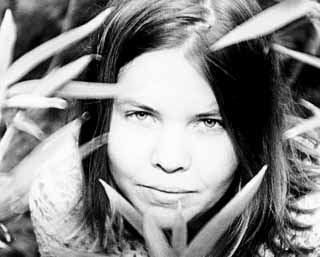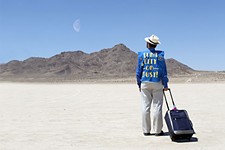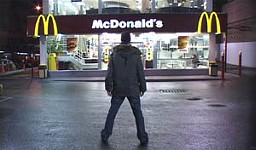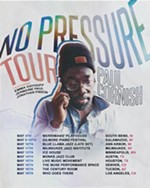Don't Drink the Water
Laura Dunn's 'Green' Examines the Effect of Petrochemical Plants on Louisiana's Cancer Alley
By Peter Debruge, Fri., Dec. 15, 2000

Filmmaker Laura Dunn loved Erin Brockovich. She cried during the movie. Not out of helplessness or relief, but because she identified with the character. Dunn recognized the same terrifying symptoms Brockovich had witnessed from her own tour of Cancer Alley, the toxic 100-mile stretch along the Mississippi River between Baton Rouge and New Orleans, where approximately 150 petrochemical plants command the land. For the past two years, while pursuing a masters degree in film at UT, Dunn has been traveling to Louisiana during every semester break, investigating the situation there, interviewing the locals, and assembling her experiences in Green, showing at the Alamo Drafthouse this Sunday, Dec. 17.
But unlike Erin Brockovich, Dunn's documentary isn't just another blow-by-blow account out to valorize some real-life civil action hero. Instead, Green concentrates directly on the problem of Cancer Alley and the people it affects, victims stuck living on polluted property so drastically devalued by its toxicity levels that the residents are no more free to leave today than some of their ancestors would have been 150 years ago, when slave owners controlled the same land where the petrochemical plants now stand. As Dunn puts it, "This is the modern plantation."
Unfortunately, no one can realistically imagine living without the products of the petrochemical industry, which supplies the key ingredients used in every single nonorganic product imaginable, from oil and gas to plastics and even -- as spokesperson Betsy Baker Miller glibly points out -- the raw film on which Dunn shot Green. While big business benefits from the fact that Cancer Alley delivers 25% of the nation's petrochemical product, Louisiana languishes. Consistently ranked among the poorest states per capita in the country, Louisiana has one of the nation's worst educational systems, the highest illiteracy rate, and the lowest proportion of people connected to the Internet. One-third of the state's children live in poverty.
"You're talking about a very uneducated population, but I was amazed with how articulate these people were, specifically when it came to talking about environmental justice issues," Dunn says. "I think it's because they deal with it so much, and it's such a battle that they have empowered and really educated themselves."
As Dunn describes it, many of the residents have simply given up hope and learned to live at the mercy of the petrochemical companies' lax, ill-monitored pollution control standards. But wherever she went, no matter how extreme the situation, Dunn found people who refused to adjust to the laws which seemed designed against them. In many cases, ordinary townspeople responded with eloquent, well-prepared arguments, as though they had been waiting around for someone to ask the right questions.
On the first day Dunn spent in Louisiana, she intercepted a National Environmental Justice Advisory Council meeting in Baton Rouge, one of only four such meetings held each year to inform the Environmental Protection Agency of public sentiment. Walking into the local union hall before the official meeting, she listened in on the citizens' public testimony, in which a stream of residents stood up to testify about atrocities in their community involving environmental issues, cancers, and injustice. Dunn furiously began taking notes. The next day, she started interviewing citizens whom she had met at the NEJAC meeting, who in turn introduced her to others facing similar situations. But everything really came together when, on her third visit to the area, Dunn chartered a private airplane to fly over the land.
"The romance of the Mississippi River is something that I had always read about, but I had never totally understood," she says. "But when you get up in the air and you see the defiance of it, it's such an incredibly beautiful river in its personality, surrounded by all this green and all these trees. I just couldn't believe the contrast between this beautiful river and all these huge [petrochemical] plants. They looked like big tumors. It was such an apocalyptic vision, made that much more so for me because I had spent so much time on the ground talking to these people."
Dunn worked hard trying to get the movie's stunning aerial shots to reflect just how awkwardly all of the toxic metal monstrosities seem to be integrated into the gorgeous river valley. Hiring Austin freelancer Vance Holmes as her cameraman and a daredevil Korean War veteran to pilot the helicopter, Dunn chose the perfect day to shoot. On approach, Baton Rouge looks as good as it would in any postcard until suddenly, from behind the Capitol building emerges a seemingly endless expanse of hideous smokestacks, corroded metal pipelines, and stagnant vats full of fluorescent substances. Simultaneously ghastly and astonishing, the sight distinguishes itself as the film's backbone.
Dunn is hardly the first to cover the story of Cancer Alley. Virtually every major news source, from Dateline and 60 Minutes to Jim Lehrer and Oprah Winfrey, have featured stories on the problems of living along Cancer Alley.
"These people are inundated with media attention on some level, but no one really documents their voice, in my opinion," she says. "Mainstream media and journalism gives you facts, it bombards you with a string of soundbites, and in the end, you're left with some pieces of information and some questions, but it's not as if you actually went down and spent some time there. That's what I wanted to do with my film, to render a place in all of its complexity: the sounds, the people, and the way time passes. You don't get that when you watch Dateline."
Dunn developed her style of capturing the human side of complicated political issues while working on her first documentary, The Subtext of a Yale Education, an overview of the labor strikes at Yale University in 1996. Along with Kyle Henry's University Inc. (about the closing of UT's Union Theatre), Dunn's film played around the country as part of the McCollege Tour double bill. Sponsored in part by Michael Moore and Richard Linklater, the tour became a grassroots awareness campaign designed to criticize the emerging corporate-mindedness of higher education. Dunn also credits her results with the fact that, despite her experience and age (she just turned 25), she could easily pass as a much younger and more benign interviewer.
"The thing I learned with documentary is you don't really get very much respect as you're making the film, especially if you look young and unprofessional," she says. "But that's the best way to be, because you disarm everyone and you earn their respect through the endurance, the fact that you keep coming back."
Drawing on her experience with the McCollege Tour, Dunn custom-tailors her presentations by inviting specialists to discuss topics of local relevance. So far, Dunn has taken the film to Denton, Texas, and then back to Louisiana for a pair of screenings at Loyola University in New Orleans and LSU in Baton Rouge. If all goes according to plan, she hopes to tour Cancer Alley in January.
"What we're doing in Austin is hopefully starting a model for what I want to do with the film in a larger context, which is use it as a catalyst, as a coming together for local environmental issues. So in Austin we're trying to get some local people to talk about issues like Stratus Properties, the impact of high tech industries on communities of color in Austin, and the upcoming legislative battle to reform the Texas Natural Resources Conservation Commission."
Unlike Erin Brockovich, Dunn's film can't offer an easy answer. In fact, both Green and all of the activities Dunn is arranging around the screenings seem more focused on helping audiences try to phrase their frustration into a manageable question.
"Where do you start? I think that is the question," she says. "If the film can leave you asking that question, then it's successful, because you're actively engaged in the material. If you're just turned off and overwhelmed in a way that's paralyzing, then I think it fails. But if you're asking yourself where to start, that's the same question I'm asking." ![]()
Green screens this Sunday, Dec. 17, at the Alamo Drafthouse, 409 Colorado. All ages welcome. Tickets are $5 ($3.50 students). 867-1839.










